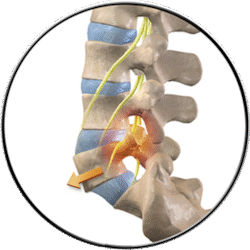Spondylolisthesis
What is spondylolisthesis?
 Spondylolisthesis (pronounced “spon-dl-oh-lis-THEE-sis”) is a condition involving the vertebrae (bones) in your spine. In spondylolisthesis, one of the vertebrae in your spine slips out of place putting pressure on nerves and causing pain. Most often, the vertebrae in the lower spine are affected causing pain in your legs when you walk or stand for a long period of time. Some patients will experience no symptoms.
Spondylolisthesis (pronounced “spon-dl-oh-lis-THEE-sis”) is a condition involving the vertebrae (bones) in your spine. In spondylolisthesis, one of the vertebrae in your spine slips out of place putting pressure on nerves and causing pain. Most often, the vertebrae in the lower spine are affected causing pain in your legs when you walk or stand for a long period of time. Some patients will experience no symptoms.
Types of spondylolisthesis:
- Degenerative spondylolisthesis: The most common form of this disorder occurs with aging. As we age, the discs between our vertebrae wear down. This is due to the loss of water in the discs making the discs less spongy and less able to resist movement of the vertebrae. Since we all age differently, spondylolisthesis can affect patients at various ages. Degenerative spondylolisthesis occurs most often after the age of 40.
- Isthmic spondylolisthesis: This occurs if you get a small fracture or break in your vertebrae due to an injury. The break weakens the bone to the point that it causes the vertebrae to slip out of place.
- Congenital spondylolisthesis: This type of spondylolisthesis is present at birth and is the result of the abnormal formation of bone. This results in the abnormal arrangement of the vertebrae in the spine and puts them at a greater risk for slipping.
Spondylolisthesis Symptoms:
Many patients will experience no symptoms and may not even know they have spondylolisthesis. Low back pain is the most common symptom spreading across the lower back, resembling a muscle strain. Muscle spasms may also be present.
Spondylolisthesis can cause tightening of the hamstring muscle causing a person to walk with a shortened gait and slightly bent knees. If the nerves are affected the pain may spread down the leg and also cause numbness or tingling to occur.
Spondylolisthesis Treatment:
Spondylolisthesis is not life threatening, therefore, not everyone will require treatment for their spondylolisthesis. Treatment depends on several factors including age, the extent of the slip, severity of symptoms and the general health and well being of the person. If treatment is necessary, there are several options available.
Conservative Spondylolisthesis treatment:
- Weight loss
- Pain medications such as nonsteroidal anti-inflammatory medications (Advil, Ibuprofen) or oral steroids
- Epidural steroid injections in which medication is placed directly in the space surrounding the spine
- Ice or heat
Physical Therapy for Spondylolisthesis:
- Stabilization exercises to strengthen the abdominal and/or back muscles
Spondylolisthesis surgery:
- Surgery to relieve the pressure on the nerves or spinal decompression surgery
- Surgery to restore stability or spinal fusion surgery
What can be done to prevent spondylolisthesis?
It may not be possible to prevent the occurrence of spondylothesis, but there are steps one can take to aid in the prevention.
- Maintain a healthy weight.
- Perform exercises to strengthen, support and stabilize your low back.
- Chose exercises and activities that are low on impact and do not place your low back at risk or injury. For example, swimming and biking are types of low impact exercise.
Experiencing Lower Back Pain?
Neuroscience & Spine Center of the Carolinas has been helping people with neck and back pain for over 30 years. Dr. Hunter and his team always start with non-surgical pain treatments like physical therapy, acupuncture, and steroid shots. If you find that your symptoms worsen or your activities are limited, then minimally invasive surgery or and other surgical treatments are an option.
Located in Gastonia, NC, The Neuroscience & Spine Center of the Carolinas serves the greater Charlotte area.

